Gulf Prairie Cemetery: A Brief History

What follows is a small article I wrote years ago (1996) about Gulf Prairie Cemetery, a historic Brazoria County locale in what is the current village of Jones Creek, Texas (between Freeport and Brazoria). It was originally done as part of an information packet given out by our county historical commission for a tour of some of the historical sites.
---<<<O>>>---
The family of James Franklin Perry and Emily Austin Bryan Perry moved from Potosi, Missouri, reaching San Felipe de Austin in the Mexican province of Texas on August 14, 1831. The family's first permanent residence in Texas was at Oak Grove on Pleasant Bayou in current Brazoria County. Emily and her younger children resided at San Felipe while James looked after the construction of a home and other improvements at Oak Grove. (During this period, their son Henry Austin Perry was born at San Felipe.) Due in part to the influence of Emily's brother, Stephen F. Austin, the family decided to move from Oak Grove to Peach Point, a move that was made around Christmas of 1832.
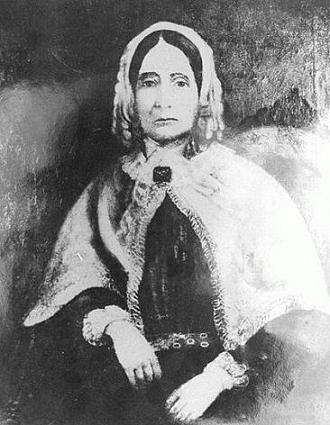
Emily Austin Bryan Perry
(Picture: Brazoria County Historical Commission)
The first burial at Gulf Prairie Cemetery was probably that of Mary Elizabeth Bryan (Emily's daughter by her first marriage), who died from cholera at Peach Point on August 4, 1833. (James F. Perry had a relative, also named James Perry, who died, presumably of cholera, on June 2, 1833, en route to Texas aboard the schooner Elizabeth, but it is probable that this family member was buried at sea rather than in the Perry family cemetery.) Another victim of the cholera epidemic who is buried in Gulf Prairie Cemetery was Henry William Munson, owner of Oakland Planation near Peach Point. Munson died at his residence on October 6, 1833.
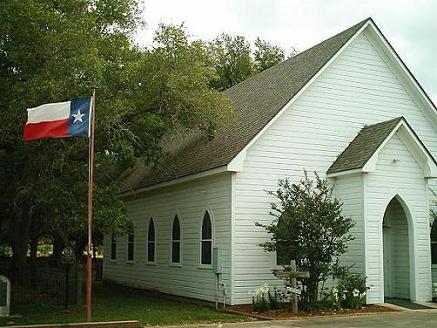
Gulf Prairie Presbyterian Church. (Taken in April 2011.)
According to a typescript report entitled "History of Gulf Prairie Presbyterian Church":
The original place of worship was a log cabin, one room, not dedicated, at Peach point (sic), where the family, visitors, and slaves worshipped (sic). This was supplied for some time prior to 1877 by any Protestant minister that came through the country; most of the time by an itinerant Methodist minister. Emily Austin Perry, Stephen F. Austin?s sister, always welcomed any minister that came by.
Among early ministers to visit Peach Point in its early years was Episcopal Church bishop Leonidas Polk, who during the Civil War was to become a Confederate Major General. Another Episcopal clergyman, Reverend Caleb Semper Ives, in 1844 visited the plantation. Yet another bishop, George Washington Freeman, visited the Perry family in the late 1840's. Also guests at the time of the bishop's arrival were future U. S. President, Rutherford B. Hayes, a college friend of Guy Bryan (another of Emily's children by her first marriage), and Hayes' uncle, Sardis Birchard, both of whom had arrived at the plantation in December 1848 and stayed on into the early part of 1849. Hayes' journal entry notes that Freeman, who was accompanied by three other Episcopal clergymen, preached "in the schoolhouse church, to a congregation of 13 gentlemen, six ladies, and five children." A record in the James F. Perry papers shows repairs were made on the church in 1855.
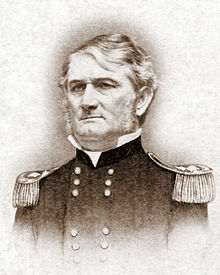
Leonidas Polk
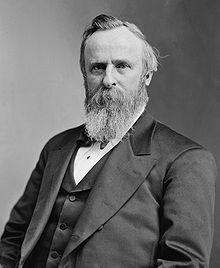
Rutherford B. Hayes
Another record, a letter by Sarah Brown Perry (Mrs. Stephen S. Perry), gives an indication of the existence of a church building that was not the original "log cabin" described in the aforementioned typescript history. Concerning losses due to the hurricane of September 1875, Mrs. Perry wrote:
...none do we feel so much regret for as our Church. It was at the family burrying (sic) ground and is level with the ground, if we could have it rebuilt immediately we could use a great deal of the old material (as the building was new) Every body feels so ruined with their own personal losses, that they say we (the ladies) must not say any thing to them about the Church But we feel that we must have our Church & are trying our friends to see is they will not help us some, will not you lend us a helping hand? We are having preaching in our parlor now.
The replacement of this building in 1877 with another small building was, according to the writer of the previously mentioned typescript, "the first dedicated church and the real beginning of this church organization." This modest building served the needs of this church organization until its virtually complete demolition by the hurricane of 1909. Immediately steps were taken to replace it with another church building that in 1946 was sold to Mrs. R. E. L. Stringfellow, who "moved it to her ranch" at nearby Durazno. The latter building was replaced, on the same site, by the present structure. It "was built largely through the special assistance" of Mrs. Lucy Bryan Harvey.
Brazoria County deed records indicate that it was not until 1890 that ownership of the property comprising the church and cemetery was conveyed by the Perry family. On January 18 of that year, James F Perry II (known as "Jimmie") transferred ownership of three acres to the Presbyterian Church. The deed concerns the land that is
a part of Peach Point plantation and comprises the plot of land on which the meeting house stands and where the grave yard is.... And this conveyance is intended as a dedication of said tract of three acres of land to the Presbyterian Church for religious purposes and for a burial ground.
Nine years later in 1899 church members decided they did not want to be responsible for managing a cemetery and deeded the entire three acres to the Gulf Prairie Cemetery Company, reserving the 50 by 60 foot plot upon which the Presbyterian Church stands.
Then in 1960 J. H. Dingle sold the cemetery association for one dollar, a one acre plot of land across County Road 304 from the cemetery thus providing room for expansion. In 1981 Oma Bell Perry, Catherine Corinne Perry and Cora Alice Perry provided yet another five acres adjacent to the original cemetery to be used for future expansion and income from leasing it for agriculture use.
Several historical markers adjacent to the church building and in or near the cemetery give testimony to the importance of this region in the history of Texas. The cemetery was the first burial place of "The Father of Texas." Stephen F. Austin died in Columbia in December of 1836 when that town was serving as the first capital of the Republic of Texas. His body was transported down the Brazos aboard the steamboat Yellow Stone to Crosby's Landing, thence to the Perry family cemetery. A bill of lading exists which is in the Brazoria County courthouse in Angleton. It shows the charges for shipment of the body ($20) and passages ($4 each) for many notables of early Texas history to Crosby's Landing and, following the funeral, passages back to Columbia. These expenses were billed to the estate of the deceased impresario.
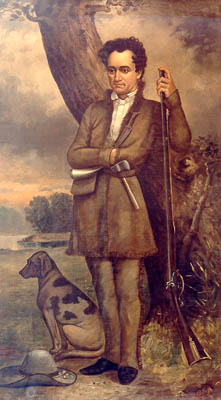
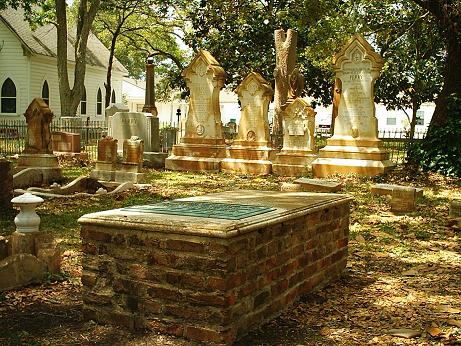
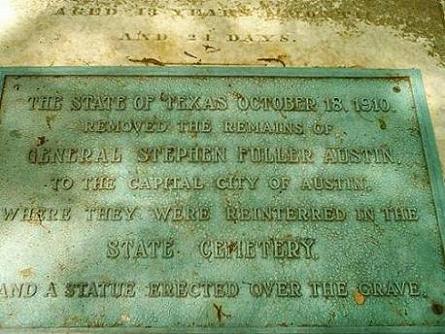
(Pictured: Stephen Fuller Austin, the "Father of Texas"; his original grave site in Gulf Prairie Cemetery; and the plaque placed at the original site after his remains were moved to the Texas State Cemetery in Austin, Travis County, Texas.)
1 comment
This post has 1 feedback awaiting moderation...

